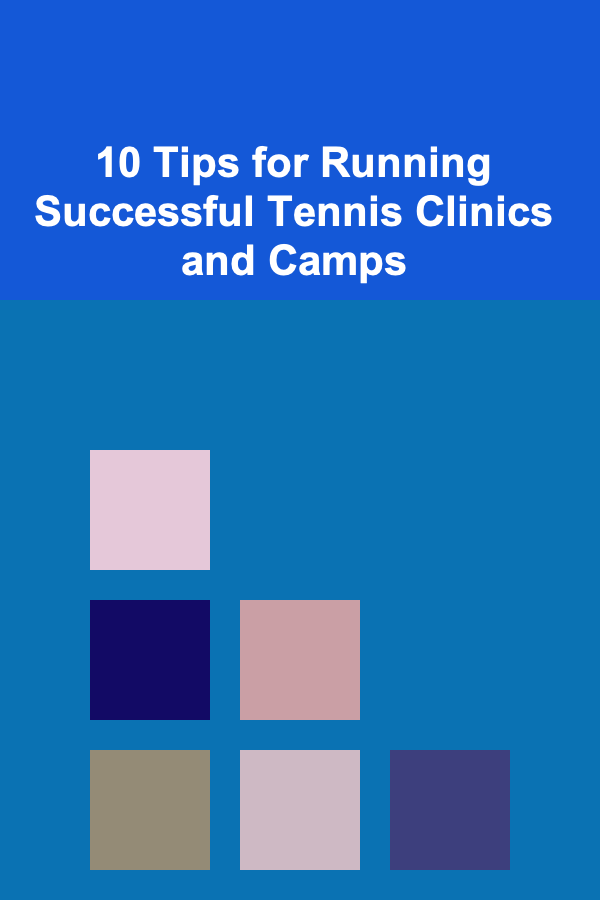
10 Tips for Running Successful Tennis Clinics and Camps
ebook include PDF & Audio bundle (Micro Guide)
$12.99$11.99
Limited Time Offer! Order within the next:

Running a successful tennis clinic or camp requires a balance of strong leadership, well-structured planning, and effective communication. Whether you're organizing a youth tennis camp or an adult clinic, your goal is to create a learning environment where participants can improve their skills, have fun, and develop a love for the sport. In this article, we'll discuss 10 essential tips to ensure your tennis clinic or camp runs smoothly and effectively.
Know Your Target Audience
Before planning your tennis clinic or camp, it's important to understand who your participants will be. Are you hosting a junior tennis camp for kids aged 8-14? Or are you focusing on adult players looking to improve their skills? Knowing your target audience will help tailor the activities, drills, and overall structure of the clinic to meet their needs.
- Juniors: For younger players, focus on making tennis fun and engaging. You should include games and drills that keep their attention, using visual aids, fun challenges, and friendly competitions.
- Adults: For adult players, the focus might shift to technique improvement, strategy, and conditioning. Adults often appreciate a structured environment with clear goals and individualized feedback.
Understanding your participants' skill levels and their primary goals will allow you to structure the clinic more effectively, ensuring a productive and enjoyable experience for everyone involved.
Set Clear Objectives
Every successful tennis clinic or camp should have clear objectives. Whether your goal is to improve specific skills, introduce new strategies, or promote fitness, make sure your participants know what they are working towards. Set measurable goals for both individual and group progress.
- Skill Development: Focus on specific aspects such as footwork, serving technique, or volleying. Break down each skill into smaller components and work progressively to develop them.
- Tactical Knowledge: Provide guidance on match strategy, such as court positioning, shot selection, and how to exploit opponents' weaknesses.
- Physical Fitness: If your clinic emphasizes fitness, include drills to improve stamina, agility, and strength specific to tennis movements.
Having a clear set of objectives not only helps participants track their progress but also provides a sense of achievement and motivation to keep improving.
Prepare a Structured Program
A structured program is crucial for keeping participants engaged, focused, and productive throughout the clinic or camp. Create a detailed schedule that outlines the flow of activities, drills, and breaks. Here's an example of how you can structure a typical day:
- Warm-up: 15-20 minutes of dynamic stretching and light cardio exercises to prepare players for physical activity.
- Skill Drills: 45 minutes to 1 hour focused on a specific skill or technique.
- Game-Based Drills: 30 minutes of tennis-related games or challenges that incorporate the skill learned.
- Break: A short 10-15 minute break to hydrate and rest.
- Match Play: 30-45 minutes of match play or controlled game situations where players can apply the skills learned.
- Cool Down: 10-15 minutes of light stretching and reflection on the day's activities.
By structuring your program in this way, you ensure a balanced day that keeps participants engaged while providing them with the opportunity to improve their skills and learn new concepts.
Provide a Positive and Motivating Environment
Creating a positive and motivating atmosphere is key to ensuring that participants feel encouraged and excited about improving. As a coach or organizer, lead by example with a positive attitude, encouragement, and constructive feedback.
- Encouragement: Celebrate even the smallest victories and improvements. Acknowledge participants' efforts to build their confidence.
- Individual Attention: While group activities are important, try to provide individual feedback when possible. Tailor your coaching to the specific needs and challenges of each participant.
- Team Building: Incorporate group activities and games that encourage teamwork, collaboration, and friendly competition.
A positive, supportive environment helps players feel comfortable and eager to participate, which in turn leads to better performance and a more enjoyable experience.
Ensure Proper Equipment and Facilities
Having the right equipment and facilities is essential for running a successful tennis clinic or camp. Here's a checklist of key items you'll need:
- Tennis Balls: Stock up on a variety of tennis balls, including low-compression balls for beginners and regular balls for advanced players.
- Rackets: Ensure that players have access to appropriate rackets. You may need a selection of rackets for various ages and skill levels, especially for younger players.
- Cones and Markers: Use cones and markers to create drills and define specific areas of the court for footwork and positioning drills.
- Water Stations: Hydration is crucial, so make sure you have water stations readily available.
- First Aid Kit: Always have a first aid kit on hand in case of injuries, along with a plan for addressing medical issues.
If you're hosting the clinic at a tennis club or facility, ensure that the courts are in good condition, with enough space for participants to practice and move freely.
Incorporate a Variety of Drills and Activities
To keep things interesting and engaging, use a variety of drills and activities that focus on different aspects of tennis. A mix of technical drills, tactical exercises, and fun challenges will keep players entertained while also improving their skills.
- Technical Drills: Focus on key skills such as serving, forehand, backhand, volleys, and overheads. Use drills that isolate specific movements and reinforce correct technique.
- Tactical Drills: Use drills that emphasize court positioning, shot selection, and match strategy. For example, drills that encourage players to hit to specific targets or work on their approach shots.
- Games and Challenges: Incorporate fun activities like round-robin games, serve speed contests, or partner drills to foster a sense of camaraderie and light-hearted competition.
By mixing up the types of activities, you ensure that participants stay engaged and have opportunities to develop well-rounded skills.
Hire Qualified and Experienced Coaches
The success of your tennis clinic or camp depends heavily on the quality of your coaching staff. It's important to hire coaches who are not only experienced in tennis but also skilled in working with the specific age group or skill level you're targeting.
- Certifications and Experience: Ensure your coaches have the appropriate certifications, such as those offered by national tennis associations, and have experience coaching players of varying skill levels.
- Communication Skills: Coaches should be able to explain techniques clearly, offer constructive feedback, and build rapport with participants.
- Enthusiasm and Energy: A coach who is passionate about tennis and enjoys teaching will inspire players to give their best effort and stay motivated.
Your staff is a reflection of the clinic itself, so choose coaches who can foster a positive learning environment and effectively guide participants.
Communicate Effectively with Participants and Parents
Clear and open communication is key to running a smooth clinic or camp. Make sure participants, parents, and coaches are all on the same page.
- Pre-Clinic Communication: Send out detailed information before the clinic starts, including dates, times, what to bring, and what participants can expect to learn.
- On-Site Communication: Maintain clear communication with participants throughout the clinic. Provide updates, instructions, and feedback regularly.
- Post-Clinic Feedback: After the clinic, solicit feedback from participants and parents to learn what went well and what could be improved. This will help you improve future clinics and camps.
By keeping the lines of communication open, you ensure that everyone involved knows what to expect and feels involved in the process.
Adapt to Different Learning Styles
Not all players learn the same way, so it's important to adapt your teaching style to meet the needs of different participants. Some players may be visual learners, while others may learn better through physical demonstration or verbal instructions.
- Visual Learners: Use videos, diagrams, and demonstrations to show techniques.
- Kinesthetic Learners: Let them practice and experiment with the movements themselves, providing feedback as they go.
- Auditory Learners: Offer clear verbal instructions and explanations of drills and techniques.
By recognizing and adapting to different learning styles, you ensure that every participant receives the instruction they need to succeed.
Evaluate and Reflect
After each clinic or camp session, take time to evaluate how things went. Reflect on the structure of the program, the effectiveness of drills, and participant engagement. This evaluation will help you make necessary adjustments to improve the clinic in the future.
- Self-Reflection: After each session, ask yourself: Were the goals met? Did participants enjoy the activities? Were there any challenges or issues to address?
- Participant Feedback: Solicit feedback from participants to learn what they liked and what they think could be improved.
- Adjust and Improve: Use the feedback to improve your future clinics or camps. It may involve tweaking the schedule, adding new activities, or adjusting your coaching approach.
By continually evaluating and reflecting on your tennis clinic or camp, you ensure that you're always striving for improvement and providing the best experience possible for your participants.
Conclusion
Running a successful tennis clinic or camp requires careful planning, effective coaching, and a focus on creating a positive learning environment. By understanding your audience, setting clear objectives, providing a structured program, and incorporating a variety of activities, you can create an experience that helps participants grow their tennis skills, stay motivated, and have fun.
Whether you're organizing a small clinic or a large camp, following these tips will help ensure the event's success, leaving participants eager to return for the next session. Happy coaching!
Reading More From Our Other Websites
- [Beachcombing Tip 101] Top 5 Prime Locations Around the World for Agate Hunting
- [Biking 101] Bike Jersey vs. Regular Clothing: Why You Need the Right Gear
- [Gardening 101] Seasonal Pruning Secrets: A Month‑by‑Month Guide for a Healthier Garden
- [Home Family Activity 101] How to Make a Family Memory Book for Special Occasions
- [Home Space Saving 101] How to Create a More Spacious Feel in a Tiny Apartment
- [Home Holiday Decoration 101] How to Use DIY Holiday Decorations to Personalize Your Home
- [Whitewater Rafting Tip 101] Navigating the Job Market: Top Careers for Professional White‑Water Rafters
- [Home Storage Solution 101] How to Use a Storage Ottoman for Both Function and Style in Your Living Room
- [Tiny Home Living Tip 101] How to Maximize Storage in a 200‑Square‑Foot Tiny House
- [Organization Tip 101] How to Teach Kids About Paperwork Organization

How to Create a Seamless Registration Process for Your Dropshipping Webinars
Read More
How to Incorporate Eco-Friendly Lighting into Your Home
Read More
How to Manage Your Pet's Weight for Long-Term Health
Read More
The Art of Recruiting: Strategies for Identifying and Attracting Top Talent
Read More
10 Tips for Work Planner Customization for ADHD Brains
Read MoreHow to Build a Simple Gift and Donation Tracker in Excel
Read MoreOther Products

How to Create a Seamless Registration Process for Your Dropshipping Webinars
Read More
How to Incorporate Eco-Friendly Lighting into Your Home
Read More
How to Manage Your Pet's Weight for Long-Term Health
Read More
The Art of Recruiting: Strategies for Identifying and Attracting Top Talent
Read More